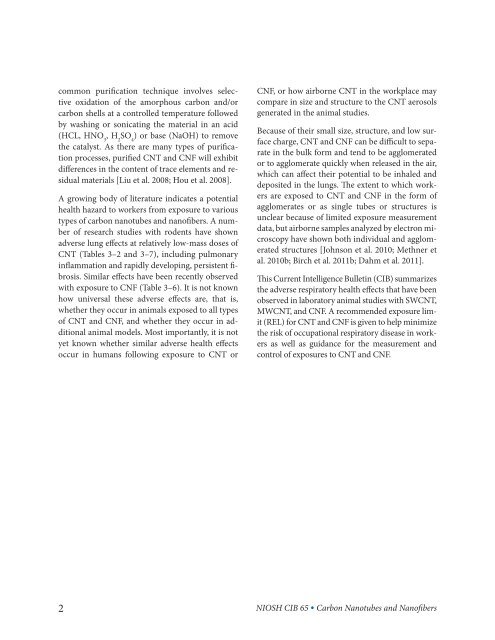Occupational Exposure to Carbon Nanotubes and Nanofibers
Occupational Exposure to Carbon Nanotubes and Nanofibers
Occupational Exposure to Carbon Nanotubes and Nanofibers
You also want an ePaper? Increase the reach of your titles
YUMPU automatically turns print PDFs into web optimized ePapers that Google loves.
common purification technique involves selectiveoxidation of the amorphous carbon <strong>and</strong>/orcarbon shells at a controlled temperature followedby washing or sonicating the material in an acid(HCL, HNO 3, H 2SO 4) or base (NaOH) <strong>to</strong> removethe catalyst. As there are many types of purificationprocesses, purified CNT <strong>and</strong> CNF will exhibitdifferences in the content of trace elements <strong>and</strong> residualmaterials [Liu et al. 2008; Hou et al. 2008].A growing body of literature indicates a potentialhealth hazard <strong>to</strong> workers from exposure <strong>to</strong> varioustypes of carbon nanotubes <strong>and</strong> nanofibers. A numberof research studies with rodents have shownadverse lung effects at relatively low-mass doses ofCNT (Tables 3–2 <strong>and</strong> 3–7), including pulmonaryinflammation <strong>and</strong> rapidly developing, persistent fibrosis.Similar effects have been recently observedwith exposure <strong>to</strong> CNF (Table 3–6). It is not knownhow universal these adverse effects are, that is,whether they occur in animals exposed <strong>to</strong> all typesof CNT <strong>and</strong> CNF, <strong>and</strong> whether they occur in additionalanimal models. Most importantly, it is notyet known whether similar adverse health effectsoccur in humans following exposure <strong>to</strong> CNT orCNF, or how airborne CNT in the workplace maycompare in size <strong>and</strong> structure <strong>to</strong> the CNT aerosolsgenerated in the animal studies.Because of their small size, structure, <strong>and</strong> low surfacecharge, CNT <strong>and</strong> CNF can be difficult <strong>to</strong> separatein the bulk form <strong>and</strong> tend <strong>to</strong> be agglomeratedor <strong>to</strong> agglomerate quickly when released in the air,which can affect their potential <strong>to</strong> be inhaled <strong>and</strong>deposited in the lungs. The extent <strong>to</strong> which workersare exposed <strong>to</strong> CNT <strong>and</strong> CNF in the form ofagglomerates or as single tubes or structures isunclear because of limited exposure measurementdata, but airborne samples analyzed by electron microscopyhave shown both individual <strong>and</strong> agglomeratedstructures [Johnson et al. 2010; Methner etal. 2010b; Birch et al. 2011b; Dahm et al. 2011].This Current Intelligence Bulletin (CIB) summarizesthe adverse respira<strong>to</strong>ry health effects that have beenobserved in labora<strong>to</strong>ry animal studies with SWCNT,MWCNT, <strong>and</strong> CNF. A recommended exposure limit(REL) for CNT <strong>and</strong> CNF is given <strong>to</strong> help minimizethe risk of occupational respira<strong>to</strong>ry disease in workersas well as guidance for the measurement <strong>and</strong>control of exposures <strong>to</strong> CNT <strong>and</strong> CNF.2 NIOSH CIB 65 • <strong>Carbon</strong> <strong>Nanotubes</strong> <strong>and</strong> <strong>Nanofibers</strong>

















